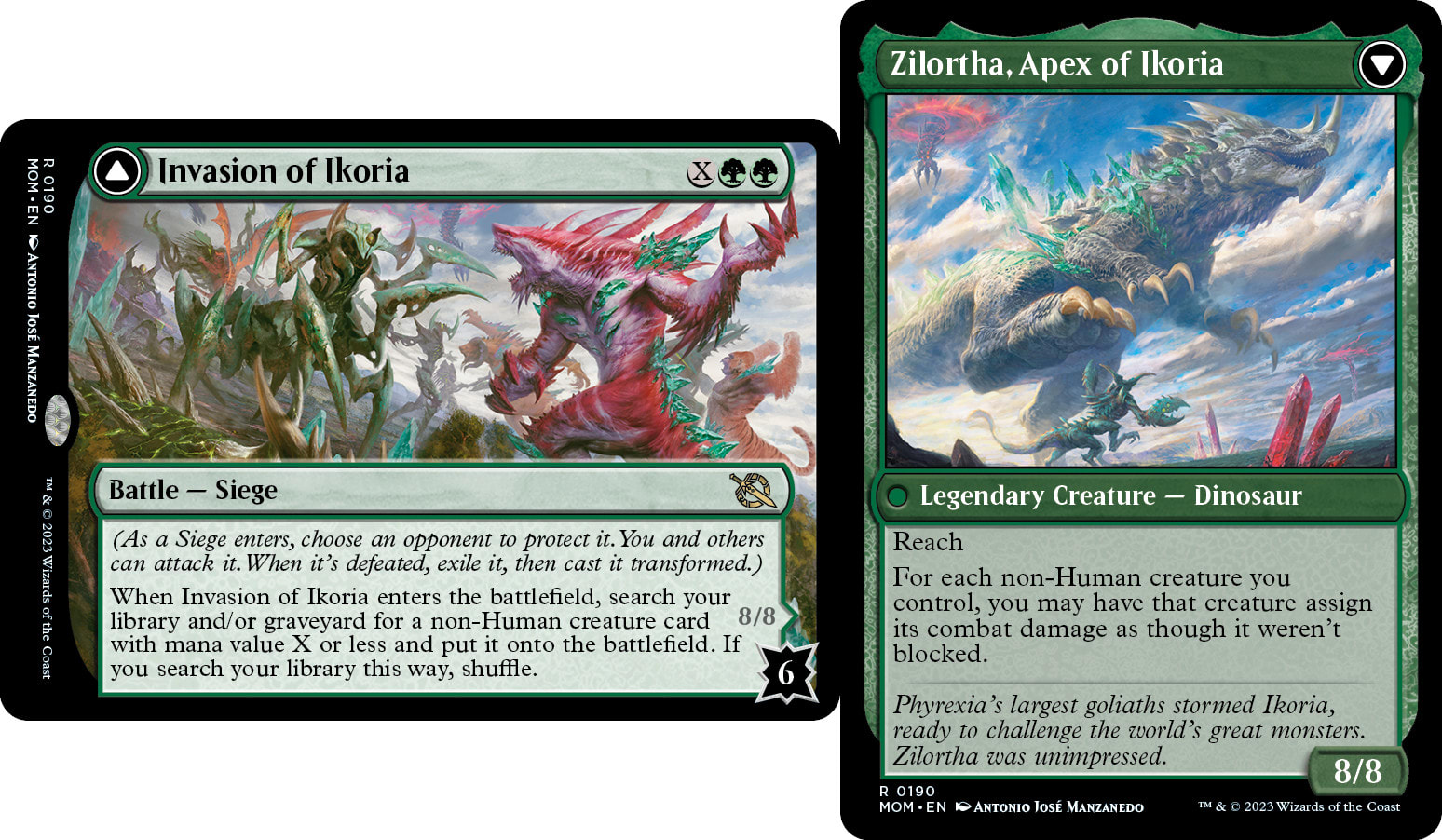Before March of the Machine, the last time we saw a brand new card type was in 2010 with the introduction of Planeswalkers in Lorwyn, often referred to as the Lorwyn Five.** With March of the Machine, we were introduced to battles--a new card type that offers a unique twist, especially suited for multiplayer formats. These cards create a "mini-opponent" for players to conquer, rewarding them with value upon success. But what exactly do battles do? Let's take a closer look by breaking down a battle card.
As this card enters the battlefield, it triggers an effect on its front side. Most battles have effects similar to those found on instants or sorceries. For example, Invasion of Ikoria allows you to search your library for a non-human creature and put it directly into play. This makes it particularly popular in Competitive EDH decks, as it can tutor powerful creatures like Dockside Extortionist and place them directly onto the battlefield. Importantly, because Invasion of Ikoria is a battle and not an instant or sorcery, it cannot be countered by spells like Swan Song or Miscast. The enter-the-battlefield effect can even be doubled with cards like Elesh Norn, Mother of Machines, or Yarok, the Desecrated.
However, unlike other permanents, battles enter the battlefield under your opponent's control, as all existing battles have the "Siege" subtype. Your choice of opponent can then use their creatures to defend the battle, preventing it from taking damage. If the defending player fails, the battle flips over, giving the casting player another powerful effect. In the case of Invasion of Ikoria, it transforms into Zilortha, Apex of Ikoria--a legendary creature that makes your creatures effectively unblockable. Other battles may transform into different card types, such as artifacts, creatures, or enchantments. Invasion of New Phyrexia, for example, transforms into a planeswalker Teferi.
Strengths of Battles
Many battles are quite powerful on their own. The front side of most battles provides valuable effects such as removal, card advantage, or even a board wipe, as seen with Invasion of Fiora. These effects are crucial for Commander decks to function effectively, making battles easy to include in the "99" with the added upside of potentially flipping them. Flipping a battle can be highly satisfying--it's not quite as dramatic as activating a planeswalker's ultimate ability, but it feels like completing a side quest in a video game. This mechanic adds a layer of enjoyment and optimization to your deck.
Weaknesses of Battles
Despite their strengths, battles have notable weaknesses. Unlike other card types, battles have not yet received any support similar to Beast Whisperer effects, so they lack synergy unless you're using cards like Tarmogoyf. In Commander, it can be easy to find an opponent with weak blockers to attack and flip the battle. However, in 1v1 formats or board-state-heavy metas with strong defenses, flipping your battle is far from guaranteed. Attacking a battle also uses up valuable combat steps that could be spent reducing your opponents' life totals. Moreover, an opponent could destroy your battle before you deal damage, using spells like Beast Within, which would eliminate the threat altogether. Additionally, when a battle flips, the new card enters the battlefield as a cast, which can be countered, leaving your battle vulnerable once more.
Should You Play Battles?
I think of battles like planeswalkers with strong ultimates--does the guaranteed effect on the front side justify a spot in your deck? For instance, the backside of Invasion of Xerex is Vertex Paladin, a flying Angel Knight with power and toughness equal to the number of creatures you control. While it's a strong creature, the initial cost to simply bounce a creature might not be worth it. This mechanic is still in its early stages, but I believe it's a good way to engage players by making them defend battles. In some scenarios, if the table perceives the backside as particularly threatening, you might be able to entice opponents into sacrificing their creatures to block it. If you do decide to include battles in your deck, I recommend casting them when you have a board state capable of attacking the battle and flipping it immediately. The longer a battle stays on the field, the less likely it is to flip.
Why Does This Matter?
This is the first new card type introduced in 13 years, which is significant. It continues to incentivize a more creature-oriented style of play, encouraging players to build decks with attackers that can reach the battle or defenders to protect it. The Siege subtype is particularly interesting as it opens the door for other types of battles in the future. Perhaps we'll see battles that need to be destroyed by a spell or sacrificed in some way. Maybe there will be stax pieces in this space that opponents can choose to sacrifice, granting the casting player the backside effect. Whatever the future holds, we can be confident that Wizards of the Coast will continue to innovate and keep Magic: The Gathering an exciting, fun, and evolving game.
I hope you enjoyed a look into the newest card type in Magic:The Gathering. I for one am a fan of these cards and I am debating adding some into my decks. You could even say I'm battling with it... Until next time, Happy Gaming!
























